Job descriptions are the first thing a potential employee will read when looking to apply for a role at your company; therefore, they are essential to master. It is vital to write a good job description if you want to attract the perfect candidate. Most job descriptions are too broad and overly detailed, resulting in a loss of the main points of the role. These lengthy job postings may prevent many candidates from wanting to apply, since they may feel they are not fit for the role, meaning a smaller candidate pool to choose from.
Why Your Job Descriptions Are Hurting You
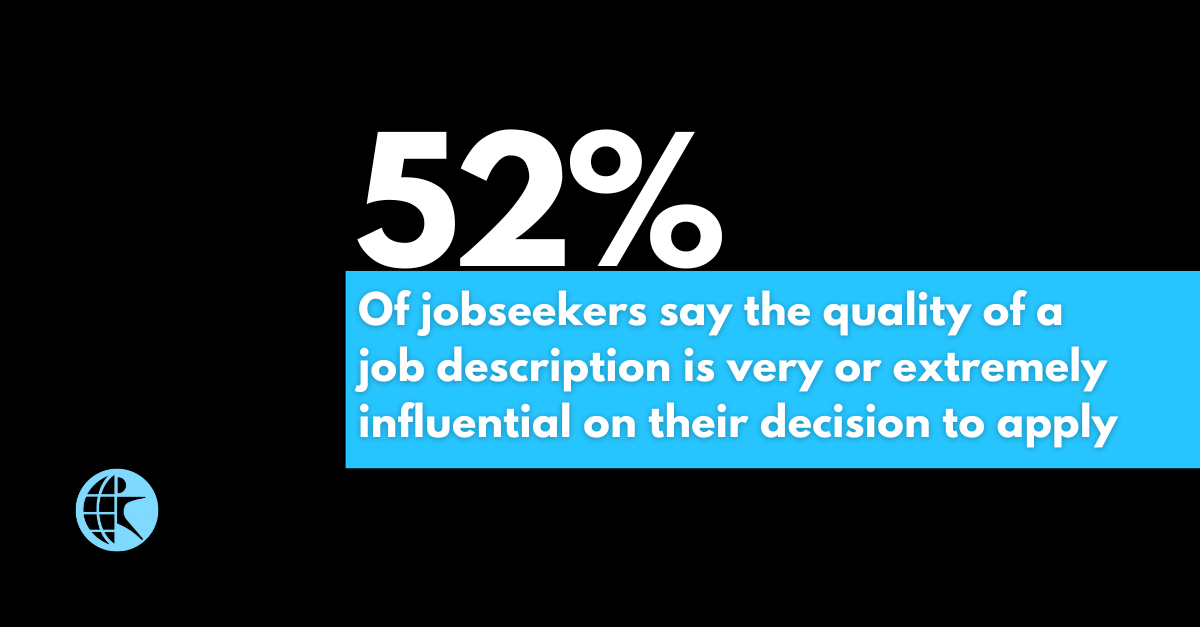
Shorter job posts get more applications. A LinkedIn study found that candidates are more likely to apply for job posts that contain short content, up to 300 words.
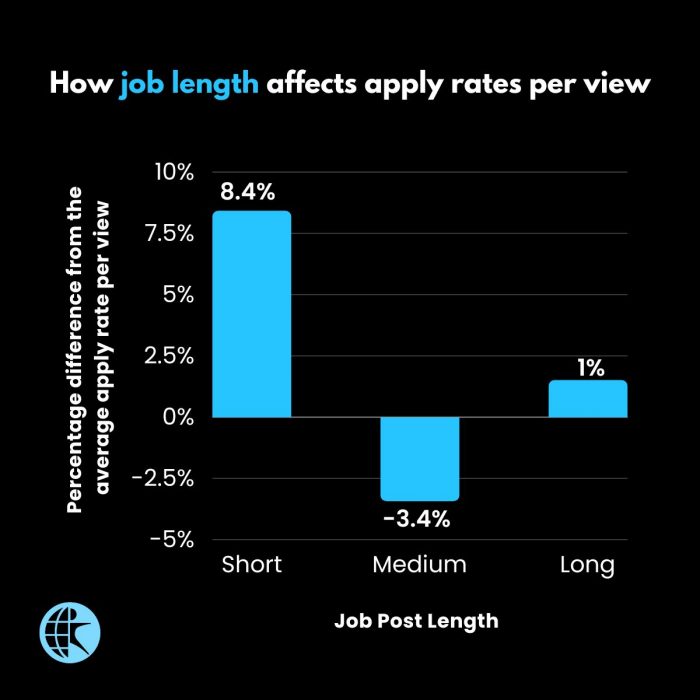
Shorter job posts (1-300 words) had significantly higher-than-average apply rates per view (the number of applications the job post got divided by the number of views). Keeping things concise helps candidates immediately get the info they need to apply—and since more than 50% of job views on LinkedIn are on mobile devices, shorter descriptions are literally a better fit for modern candidates. These short posts got candidates to apply 8.4% more than average, while medium job posts (301-600 words) performed 3.4% below average and long job posts (601+ words) did only 1% better than average. Via LinkedIn.
See Related Article: Less is more.
Evolve your job descriptions to be less overwhelming and meet realistic position expectations. Attempt to narrow all your job requirements to the top three mandatory requirements. From there, work in the following nonnegotiable requirements and experiment with condensing. Instead of listing 20 bullet points, expand on your company culture and what a full day of work may be like.
A job description that does not state too many requirements increases the number of candidates fit to apply—therefore, you will have a broad selection of potential candidates to choose from. There are really two or three main requirements in most roles, if the candidate meets the core 3 – everything else can generally be taught or expanded. Think about this when writing your next job description. Ask yourself: “Why are people going to be excited about this job?”
Paralysis by Overanalysis? Overcome Choice Overload
The average adult makes more than 35,000 decisions per day. From the moment we wake up, we’re bombarded with choices. Some are small like what to have for breakfast, others are more important, like considering a career change. In tandem, they can weigh heavily on our mental state and quality of life. This is known as choice overload, it causes decision fatigue leaving you emotionally distraught, irritable and paralyzed.
This level of mental wear can make even a benign task like picking up toothpaste seem exhausting. An average grocery store has over 39,500 items, and this one in particular, while conveniently located on your way home from the office, has over 40 types of toothpaste, all of which swear will give you white teeth and a (winning smile).
In a Ted Talk, Barry Schwartz, author of Paradox of Choice – Why More is Less, gives a great example of choice overload:
Barry tells the audience about a study done on investments in voluntary retirement plans, Barry got investment records from Vanguard for about a million employees and 2,000 different workplaces. “For every 10 mutual funds the employer offered, the rate of participation went down 2% - so if you offer 50 fund options - 10 % fewer employees participate than if you only offer 5 fund options. Why? Because with 50 funds to choose from it is so hard to choose which fund that most people will just put it off. This means making the decision is so hard that employees pass up significant money from their employers. Paralysis is a consequence of having too many choices."
On the other hand, businesses often unconsciously put consumers in a state of decision fatigue. Business owners can remedy this problem by categorizing and narrowing down their products and options, alleviating choice overload for consumers.
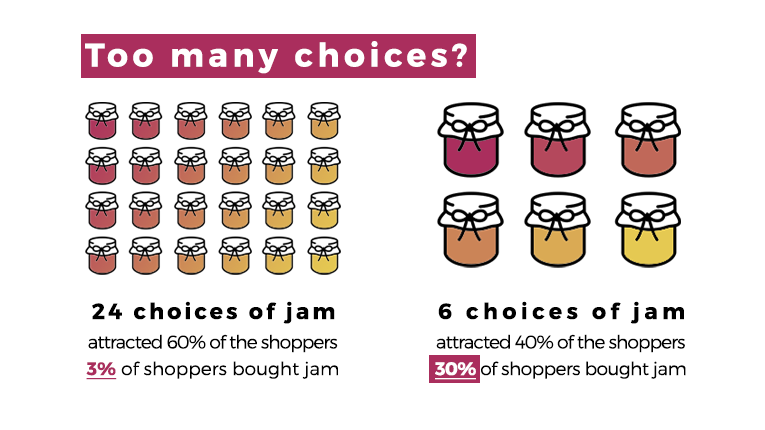
In The Jam Study, by Sheena S. Iyengar she experimented with a jam stand offering samples in a grocery store. One stand had 24 choices and one had six. 40% of the shoppers tried the jams and 30% made a purchase. With more options, 60% tried the jams, but just 3% made a purchase. The conclusion: “choice is alluring but confusing”. Customers given too many choices are ten times less likely to buy.
Dealing with choice overload is a responsibility both consumers and businesses have to share. Consumers can make themselves more resilient toward the daunting number of choices in their day by practicing some of these tips:
Tips to overcome choice overload:
- Be mindful about your choices
- Narrow down to what is important
- Categorize items into groups
- Set a time limit on decision-making
- Practice on the small stuff
- Decide and commit
- Make some choices automatic
- Go with your gut
Leadership Vs. Management
The terms “leadership” and “management” are often used interchangeably. While there is some overlap between the work that leaders and managers do, there are also notable differences. The main difference between leaders and managers is that leaders have people follow them while managers have people who work for them.
Leaders are more about looking for opportunities for improvement company-wide, whereas managers set out to achieve organizational goals through implementing various processes. While managers have procedures, leaders have a vision. Leaders are more intent on thinking ahead and capitalizing on opportunities down the road. Both pieces of the puzzle are equally important.
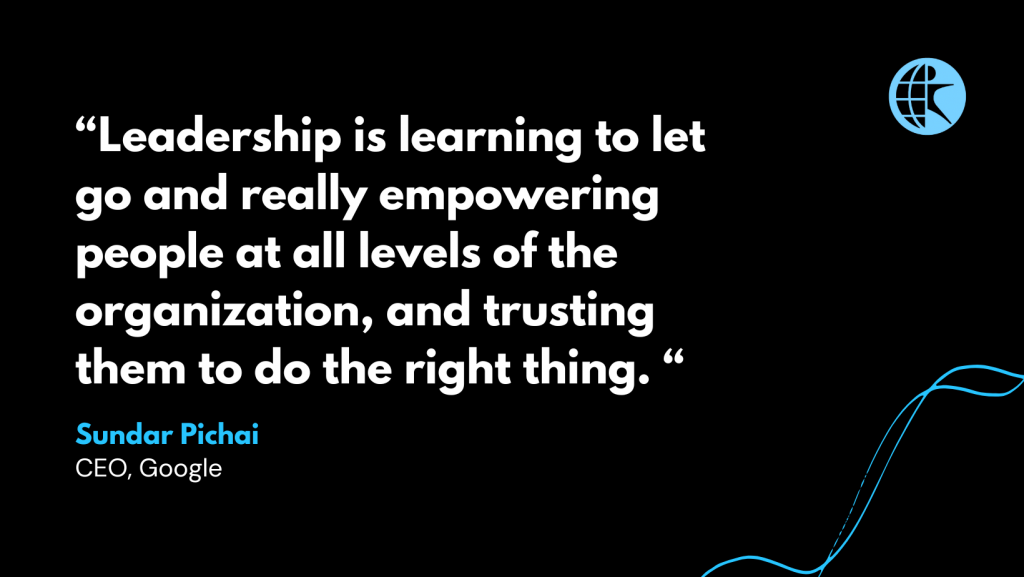
Leaders create an open environment in which their teams are comfortable enough to speak up and consistently communicate. The leader encourages and inspires, focusing on people and overall improvements. The manager sets realistic expectations and benchmarks focusing on systems and structure. While managers work in the present, leaders look to the future.
See Related: Daily Habits of the Most Productive Leaders
“Employees who work for engaged managers are 59% more likely to be engaged themselves.”- Gallup
In addition to inspiring employees, leaders engage in learning and development making it a priority for themselves and their managers. Whether you are a leader, a manager or a mix of both. Strive to lead and manage with passion and integrity. Leaders inspire people and managers drive their success, effective work systems should have a healthy balance between the two.
Lateral Career moves: Try a Sideways Approach
A lateral move is a career change where an individual moves from one position to another with little change in their salary, title, or level. That may not sound enticing, but hear me out. Career shifts are bound to happen throughout your career and lifetime. So why not explore and learn as much as possible to make more informed decisions about where you want to take your career?
A lateral move can be the start of a more fulfilling career. A move like this can improve many parts of your work life and possibly be the stepping stone to your dream job.
We’ve all seen something like this:
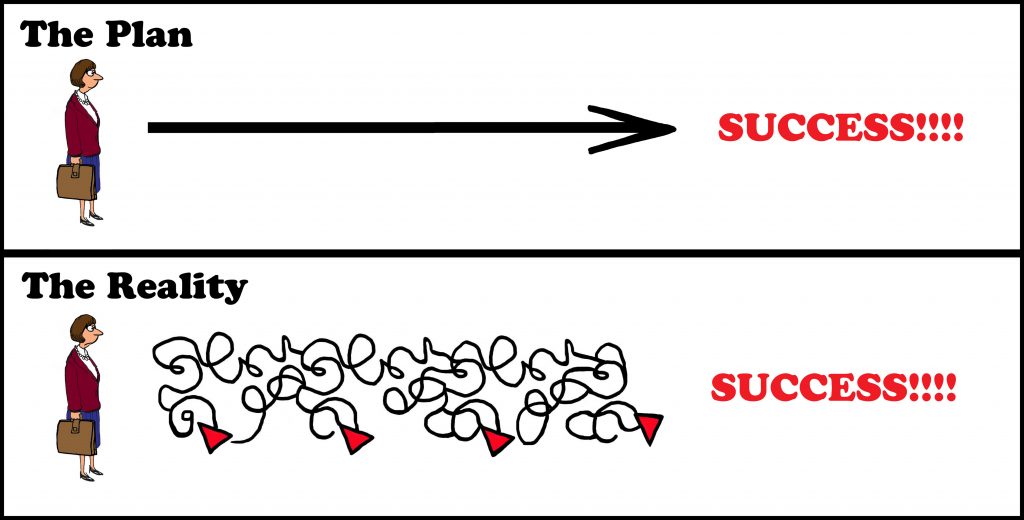
Success is funny. Most of us want to get to it as fast as possible without realizing how vital the progression to the finish line is.
We’ve all used Waze to find an alternate route to arrive at the same destination. Did that detour provide you with value in any way? Perhaps you discovered your new favorite scenic view or turned an unfamiliar face into a friend? Found a $20 bill? Came across a yard sale, a great coffee shop, ran into superman? The point is – it is great to be highly motivated and eager to reach a certain level of success or the next step in your career. It is just as important to recognize the value of the sidesteps and the little nuances that may put you in the right place at the right time down the road. Don’t confuse a detour with a lack of progress.
Perhaps a steppingstone off to the side will require a greater investment of time, but it can also teach you a new skill or establish a new life habit that is the sole reason for your future success. If you were to treat the sidesteps, back steps and U-turns with the same attentiveness as your end goal – you may be all the wiser.
Success doesn’t happen overnight. It is the small increments you put towards the big goals every day that create success. It is almost as if the process is more influential than the result – so why rush the experience?
See Related Article: Career Progression and Career Paths are Rarely Linear.
There are pros and cons to everything. Here are a few pros of a lateral career move:
- Gain exposure to a different area of your industry
- Better flexibility
- Improved learning environment – mentors available
- Network expansion
- Improved culture and quality of work-life
- Better training and education
Cheers to your current progress and future success.
Take Ownership of Your Career Progression
Compensation Strategy. What is it & Why You Need It.
Compensation strategies help increase the motivation and retention of your employees. Compensation shows your employees and interested candidates that you value them. This may also be seen as an indication of how fairly they will be treated as an employee.
Having an established compensation strategy allows you to predict costs for hiring new employees and providing salary increases along the way. It also helps avoid situations where pay decisions may be inconsistently applied.
Compensation strategies can be used to:
- Hire and retain employees
- Increase your employees’ level of satisfaction with the job
- Reward and inspire peak performance
- Achieve internal as well as external equity
- Lessen turnover and boost company loyalty
Keep your employee compensation strategy updated with current market data so you can stay competitive in the candidate market. A strong employee compensation offer shows prospective employees how enthusiastic you are about having them on your team, and helps you land. In turn, existing employees should benefit from the same salary range increase to ensure that you can retain them by providing fair compensation.
Easy Steps to Create a Strategic Compensation Strategy:
- Understand what matters most.Find out what benefits matter most to your staff. By asking for input, you can create an informed strategic compensation approach that fits with your talent management strategy and will satisfy most employees.
- Benchmark Against Competitors.To remain competitive in your industry and the locations where you conduct operations, take time to benchmark what your competitors offer their employees. You may not be able to match them item for item, but with this information, you will be able to address gaps during interviews. Get creative about other, lower-cost options you can include in your total compensation package.
- Allocate Budget.Take a realistic look at your company’s operational budgets. Identify the total amount you can spend on any one employee. Factor in all costs, including taxes, payroll costs, existing benefits, compensation, and bonuses. Include plans for performance or merit increases that will take place as part of annual reviews.
- Plan for Rewards.As you make your budget, consider how you can use total compensation to engage employees, increase performance, and entice them to stay.
- Determine Pay Grades.Having this framework allows an organization to define the amount of pay available based on the job’s requirements and level. Pay grades take the guesswork out of salaries and provide employees with a range of what they can expect to make.
- Communicate About Total Compensation.The gap between expectations and reality is one of the largest issues between employers and employees that creates dissatisfaction. When you clearly communicate your total compensation strategy, employees know what to expect and appreciate all the benefits you are providing, in addition to the pay.
Appropriately compensated employees feel that they add value to the company. When employees feel appreciated, they feel good about coming in to work. This raises the morale of all employees and people are encouraged to come to work with a good performance.
Talent is your top competitive advantage, and compensation is how you show employees how valuable they are to your organization.
Happy Planning!
2022 Midyear Pay Increases: The Right and Wrong Way
It is no secret that higher costs of living and rising inflation have affected the market. Just take your vehicle to the nearest gas station and squeal as you see the numbers spin. The U.S. inflation rate reached 8.6% in May, becoming a 40-year-high. Add in a dash of market competitiveness and retention concerns and the pressure for companies to keep up with rising prices is on.
In a recent article, SHRM noted a survey of 337 U.S. companies by pay consultancy Pearl Myer finding that about one-third of organizations are considering or planning to provide mid-year salary increases in 2022:
23 percent of companies are planning midyear salary adjustments in addition to their annually scheduled pay increases. An additional 8 percent are considering this action. "It is very unusual to see so many companies planning a second round of adjustments," said Rebecca Toman, vice president of the survey business unit at Pearl Meyer, based near Boston. "Normally, budgets are set well in advance for an annual rise. This is further indication that a shift is occurring—at least for now—when it comes to setting pay for the established workforce."
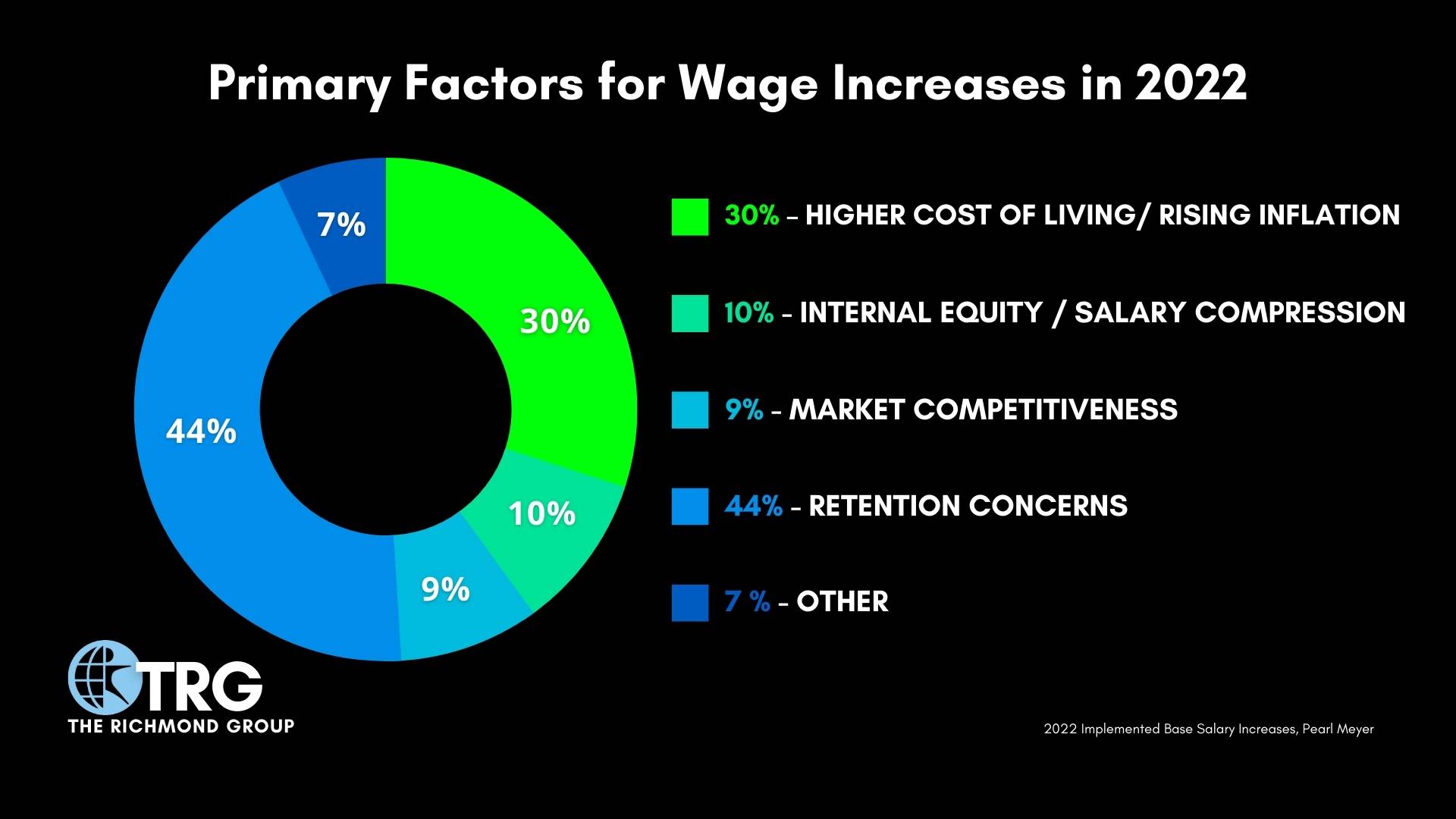
Why are raises occurring?
The most prevalent factors for wage increase in 2022 are retention concerns, higher cost of living and rising inflation, internal equity and salary compression, high turnover rates, shortage of labor and market competitiveness. This perfect storm resulted in organizations raising salaries and benefits to retain and attract talent within their industries.
At The Richmond Group USA, we believe there is a right and wrong way to give a raise. When thinking about giving a raise, ask yourself:
How do you decide who to give a raise to and how much? Do you have a compensation strategy plan for your employees? Are you reactively or proactively giving this raise? Are you adjusting salaries based on annual merit raises and COLA factors? Are you structuring your pay system and processes?
Raises are customary, though we believe having a thorough discussion and tying a raise to agreed-upon goals is more rational and less arbitrary. Don’t put yourself in a compensation mess just to compete with the market. This will negatively affect you and your employees. Ensure you have a strategy and plan to give deserved raises to employees systematically.
Disconnection throughout your organization creates conflicts, if you are paying your employees what they deserve and giving raises routinely based on performance – you won’t find your company needing to compete.
We base our practices on being proactive, not reactive – resulting in a greater overall impact.
Have a plan so that the reasons you adjust salaries are creating impact and value among your employees and business. Use pay increases to set targets, goals and objectives, don’t just check off a box and add a number. Create a roadmap together.
Are You Aware You are Making Assumptions?
Do you ever stop yourself and ask, “How do I know?” or do you jump to conclusions?
Assuming really can make an ass out of u and me. Assuming can also be the reason you do not consider an opportunity or idea.
There are two sets of assumptions when working with another person: yours and theirs.
Our team discussed how important it is to engage and take a step back during conversations to examine any assumptions. There are many ways to be aware of others making assumptions during conversations, asking assumption discovery questions like, “My sense is that you may not be all that interested in this opportunity based upon…” “Why do you think or feel this way?” “On what basis do you believe … and how do you know this is the case?”
At The Richmond Group USA, we practice having the confidence to challenge assumptions that may hinder motivations and desires to pursue, perceive and obtain great opportunities.
In the book Unleashing the Power of Unconditional Respect: Transforming Law Enforcement and Police Training, authors Jack Colwell and Chip Huth write:
We automatically tend to assume the following:
The way I see something is the way it is.
The way I feel about someone is the way he or she is.
The way I remember an event is the way it was.
If you disagree with me, you are stupid, a liar, or psychotic (disconnected from reality).
The irony is that this assumptive thought base (all problems and misunderstandings are external to me) IS the apex of self-imposed ignorance, deception, and even psychosis. Probably the only reason it is not considered pathological is that it is endemic.
Why do we naturally make assumptions? Assumptions are an efficient way to process the world. Our brain saves energy by making assumptions. Analyzing each situation without any bias or assumptions takes a lot of energy, attention and self-awareness. Our brains look to our experiences to find patterns in how the world works (Or how we have perceived the world in former times). When we encounter new situations, we apply these patterns or assumptions to the new environment.
Next time (because there will absolutely be a next time) you find yourself assuming something, stop and ask yourself:
“What do I really know for sure and what don’t I know?” “What assumptions am I making that have led to my decision?”
The more you evolve your thinking and become conscious of your assumptive thinking the better informed you will be in all areas of your life.
Becoming aware of your assumptions is the start of limitless opportunities.
Are You in Control of Your Day?
Have you heard the saying “if you want something done give it to someone that is busy”? Well, its true success is connected to action, however, it is not necessarily connected to staying busy. A better version of the saying is “if you want something done give it to someone that is productive.”
Are the most successful people in the world really the busiest? Or are they the most productive and least distracted?
Being busy and being productive can often be confused with one another. If you are busy, you may have a lot on your plate, but this doesn't necessarily mean you are productive or using your time efficiently. Being productive means being able to complete a task or get something done. You do not need to be busy to be productive.
Being busy has to do with how you spend your time, whereas productivity has more to do with what you accomplish.
BUSY
Busy
[Busy is defined as having a great deal to do. ]
PRODUCTIVE
Productive
[Productive is defined as achieving or producing a significant amount or result. ]
So, do you just have a great deal to do or are you actually producing a significant amount of results?
A lot of people are great at “looking and feeling busy,” but not so great at actually being productive. Having a busy mindset can feel disorganized and fast-paced, resulting in you working harder, not smarter. Having a productive mindset is more action-oriented and result-driven, keeping you organized, steady-paced and working smarter, not harder.
Those with higher emotional intelligence (EQ) are typically less busy and more productive. Busyness can lead you to overextend yourself with varied obligations, appointments, commitments, and responsibilities leading to less success overall. Being productive versus being busy will be the reason you hit your goals.
How do you become more productive and less busy? The answer is to be in control of your focus. Naturally, we will have many distractions and attention grabbers throughout the day. The most productive people can filter through the noise adjusting their attention to result-driven actions.
The Organized Mind: Thinking Straight in the Age of Information Overload, a book by Daniel Levitin, has an interesting section on cognitive overload and how it correlates to productivity. Levitin points out an interesting fact on how highly successful people (HSP) differ from the rest of us when it comes to attentional filters.
What is an “attentional filter?”
Simply put, our attention is limited. To pay attention, the brain uses a filtering system known as the attentional filter.
This passage from Levitin’s Book explains it well:
In order to understand one person speaking to us, we need to process 60 bits of information per second. With a processing limit of 120 bits per second, this means you can barely understand two people talking to you at the same time. Under most circumstances, you will not be able to understand three people talking at the same time. … With such attentional restrictions, it’s clear why many of us feel overwhelmed by managing some of the most basic aspects of life. Part of the reason is that our brains evolved to help us deal with life during the hunter-gatherer phase of human history, a time when we might encounter no more than a thousand people across the entire span of our lifetime. Walking around midtown Manhattan, you’ll pass that number of people in half an hour. Attention is the most essential mental resource for any organism. It determines which aspects of the environment we deal with, and most of the time, various automatic, subconscious processes make the correct choice about what gets passed through to our conscious awareness. For this to happen, millions of neurons are constantly monitoring the environment to select the most important things for us to focus on. These neurons are collectively the attentional filter. They work largely in the background, outside of our conscious awareness. This is why most of the perceptual detritus of our daily lives doesn’t register, or why, when you’ve been driving on the freeway for several hours at a stretch, you don’t remember much of the scenery that has whizzed by: Your attentional system “protects” you from registering it because it isn’t deemed important. This unconscious filter follows certain principles about what it will let through to your conscious awareness.
Not giving your full attention is a sacrifice made on the quality of your thoughts and your work. To be more productive and less busy learn to be more present and in the zone with anything you're trying to finish or accomplish. Practice focusing on one thing at a time and fully completing one task before jumping to the next.
Use your attentional filter to your advantage. Filter out the less important things and give 100% of your focus to tasks that drive value and productivity. Being in control of your day will not only help you obtain your goals but will also increase your confidence, decisiveness, and self-esteem by knowing you run your life and your life does not run you.










